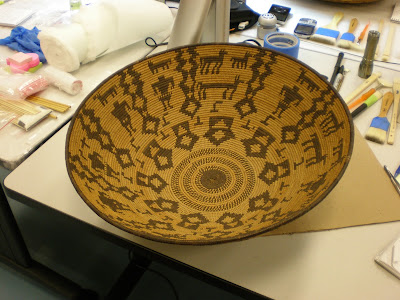At Spicer Art Conservation we specialize in textiles, paper and objects. "Objects" is a broad category, but for us it is typically an object made of organic material that is difficult to treat, and so we are contacted for its conservation. We treat objects made of uncommon organic items, like: bone, skin, feather, hair, porcupine quill, horn, bark and a variety of species of grass, to name a few. Baskets, of course, are typically constructed of grass, but are also often embellished with additional items (feathers, glass beads, quills) making them a compound object, which could make them particularly complicated.
 |
| A basket surrounded with tools to clean, conserve, and create safe storage for it. |
Baskets are often not alone in a collection, instead they exist in groups, sometimes very large groups.
A few years ago, Spicer Art Conservation and other conservators had a great opportunity to clean, rehouse, and condition a very large group of baskets. The collection of over 700 baskets were owned by the United States Department of the Interior.
 |
| A small sampling of some of the baskets in the US Department of the Interior collection. |
The first portion of the DOI collection was gathered in the 1930's by the first Secretary of the Interior, Mr. Harold Ickes, who then gave them to the people of the United States. It is a little known collection, but with the now improved access and storage, more research on the collection will be made. What is evident is that within the collection are great examples of all types of baskets from North America. Read more: http://www.doi.gov/museum/upload/Interior_Shelves_newsletter_2010_issue1.pdf
Baskets have been used by humans for 1000's of years and they have many characteristics: they are vessels, sometimes with a lid. Baskets are woven, coiled, stitched, braided, knotted or put together in creative ways which make them come together in a specific shape. Baskets are purposeful or decorative, exchanged in trade or tourism. Each of these qualities are what determines the conservation of the object.
Many baskets come to us embedded with dirt. This is not surprising as baskets are incredibly dimensional with surfaces of "nooks and crannies". Baskets can loose their shape over time, slouching or warping below their own weight. These two concerns are addressed during the conservation treatment of a basket. First the basket is vacuumed with low suction and a brush attachment to release any loose dirt on the surface both inside and out. Next the basket is cleaned with swabs and a mild enzymatic cleaner. Stabilization occurs as the basket requires it; this can be in the form of a full internal support or refastening loose embellishments or handles.
 |
| The glass beads on this basket were encrusted, both in and outside with dirt. Custom-made fine cotton swabs were used to gently remove the embedded dirt from each individual bead. |
 |
| Swabbing the lip of a basket to remove dirt. The swabs are created from cotton batting to custom-produce the best size and shaped swab for the job. |
Read more about basket conservation and how to create storage supports in a National Park Service "Consev-o-gram": Storage Supports for Basket Collections
Read all about SAC's conservation of an enormously large basket in our previous blog: "The After Life of an Enormously Large Basket", where we discuss the store and support of a basket on a very large scale.
 |
| The "enormously large basket" |
_____________________________
Gwen Spicer is a textile conservator in private practice. Spicer Art Conservation specializes in textile conservation, object conservation, and the conservation of works on paper. Gwen's innovative treatment and mounting of flags and textiles is unrivaled. To contact her, please visit her website.



No comments:
Post a Comment